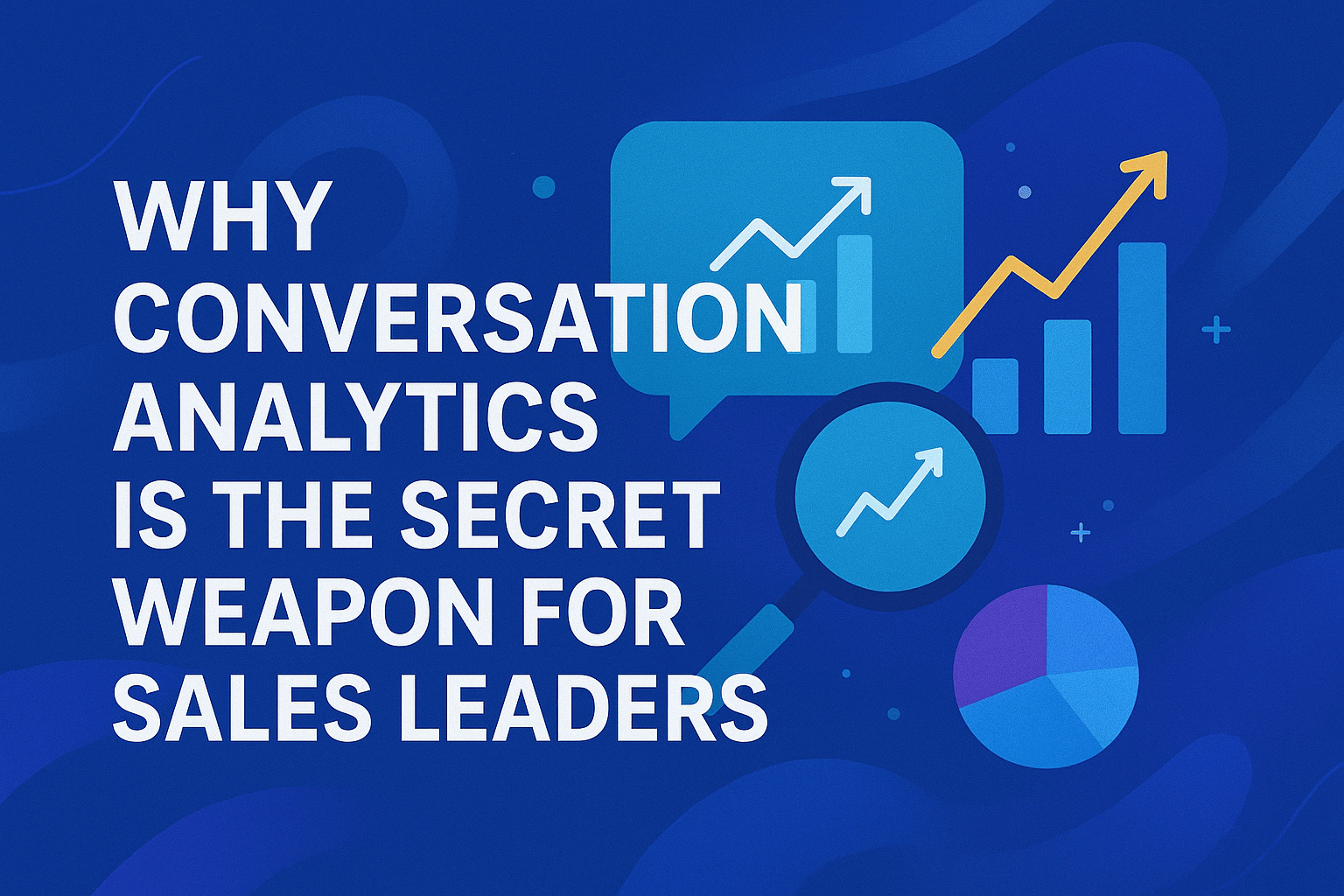
Introduction: Why Sales Leaders Need a New Edge
Sales has always been a high-stakes game—but in today’s environment, the pressure is even greater. Buyers are more informed, competition is fierce, and digital channels create a flood of interactions that are impossible for managers to monitor manually. Every sales call, chat, or email contains valuable insights—what messaging resonates, how objections are handled, and where deals are at risk. Yet, most organizations leave these conversations unanalyzed, missing out on a goldmine of data.
That’s where conversation analytics comes in. This AI-powered technology captures and analyzes customer interactions across voice, chat, and email, turning unstructured conversations into actionable insights. For sales leaders, it’s nothing less than a secret weapon—helping them coach teams effectively, refine strategies, and ultimately drive higher conversions and revenue.
Forrester reports that insights-driven businesses are 8.5× more likely to achieve year-over-year revenue growth of 20% or more (Nextiva). That statistic alone shows why ignoring conversational data isn’t an option anymore.
1. Turning Every Conversation Into a Coaching Opportunity
Most sales managers only get to listen to a handful of calls each week. That means they’re coaching with a very limited view of rep performance. Conversation analytics changes the game by transcribing and analyzing every single call.
- It highlights the specific phrases top performers use.
- It flags common objections and how effectively they’re handled.
- It pinpoints moments where deals get stuck or momentum drops.
With this visibility, leaders can deliver targeted, data-backed coaching instead of relying on gut feeling. According to Calldrip, businesses that integrate conversational insights into coaching programs see measurable improvements in win rates and ramp-up speed for new reps.
Imagine telling a rep: “On your last 20 calls, you interrupted the prospect before they finished speaking 40% of the time, compared to our top closer who only interrupts 8%.” That’s the kind of precision feedback conversation analytics makes possible.
2. Messaging That Resonates (and Converts)
Sales success often comes down to language. Which words inspire trust? Which talking points stall the conversation? Conversation analytics provides a scientific lens on messaging effectiveness.
For example, Invoca found that analyzing thousands of conversations revealed that simple word changes—like using “investment” instead of “cost”—increased close rates significantly.
Sales leaders can:
- Build playbooks based on winning language.
- Test new pitches and measure their real-world impact.
- Share top-performing scripts across the team.
Instead of guessing, leaders now have hard data on what works and what doesn’t. That means sales messaging isn’t just crafted in a marketing room—it’s validated by customer response in real conversations.
3. Uncovering Sentiment and Hidden Buying Signals
Beyond words, tone and emotion matter. A prospect may say, “I’ll think about it,” but conversation analytics can detect hesitation in voice or lack of enthusiasm in word choice. These subtle cues often indicate deal risk.
According to Omniconvert, sentiment analysis within conversations helps sales teams identify:
- Which customers are at high churn risk.
- Which prospects show strong buying intent.
- Which interactions require escalation to a senior rep.
McKinsey has reported that organizations using conversational intelligence achieve 10% higher customer satisfaction scores and 20–30% cost savings due to smarter prioritization (UCToday).
For sales leaders, that means a clearer line of sight into which deals need attention today—before opportunities slip away.
4. Driving Efficiency and Scale
Conversation analytics isn’t just about improving what reps say—it’s about optimizing the entire sales operation.
According to Dialpad, organizations use these tools to:
- Route calls more effectively by matching customer intent with the right rep.
- Reduce average handle time by giving reps contextual insights instantly.
- Automate reporting and save managers hours of manual review.
This efficiency translates into real dollars. If each rep saves even 15 minutes per day thanks to AI-powered analysis, a 50-rep team gains back over 300 hours per month—time that can be reinvested in revenue-generating activities.
5. Feeding Insights Back Into Strategy
Sales leaders aren’t just managing teams—they’re shaping go-to-market strategies. Conversation analytics provides a continuous feedback loop from the front lines.
- Marketing gets insight into which campaigns drive quality conversations.
- Product teams learn which features prospects care about most.
- Executives gain visibility into real customer objections, not just anecdotes.
According to LivePerson, companies that analyze conversations holistically are better positioned to anticipate customer needs and adjust offerings quickly.
In other words, sales leaders using conversation analytics don’t just close more deals—they influence company strategy with hard evidence.
Case Study Example: Unlocking 25% Higher Close Rates
Consider a mid-sized SaaS company struggling with inconsistent close rates across its sales team. By implementing conversation analytics, leadership discovered that:
- Top performers consistently asked three open-ended questions before pitching.
- Struggling reps tended to rush into demos without discovery.
- Prospects who heard case studies during calls were 25% more likely to convert.
By coaching reps to replicate these winning behaviors, the company saw close rates increase by 25% in just one quarter.
This illustrates the compounding effect of conversation analytics: once insights are embedded into team behavior, every rep improves, and overall performance skyrockets.
Implementation Roadmap for Sales Leaders
Getting started doesn’t require overhauling your entire tech stack. Here’s a simple roadmap:
- Set clear goals – Decide whether your priority is improving close rates, reducing churn, or refining messaging.
- Integrate tools – Choose a platform that connects with your CRM and communication channels (Qualtrics).
- Pilot with a small team – Test insights on one sales pod before rolling out company-wide.
- Embed in coaching – Make conversation insights a core part of weekly one-on-ones.
- Measure and iterate – Track metrics like win rate, call quality, and deal velocity over time.
Conclusion: A Secret Weapon No Sales Leader Should Ignore
In the age of AI, sales leaders can no longer afford to manage teams based on instinct alone. Conversation analytics provides the visibility, precision, and scale needed to drive consistent performance across the sales org.
It empowers leaders to coach smarter, craft messaging that resonates, and anticipate customer needs—all while boosting efficiency and revenue.
As competition intensifies, conversation analytics is fast becoming not just a competitive edge, but a strategic necessity. For sales leaders ready to thrive in the digital-first era, it truly is the secret weapon.

